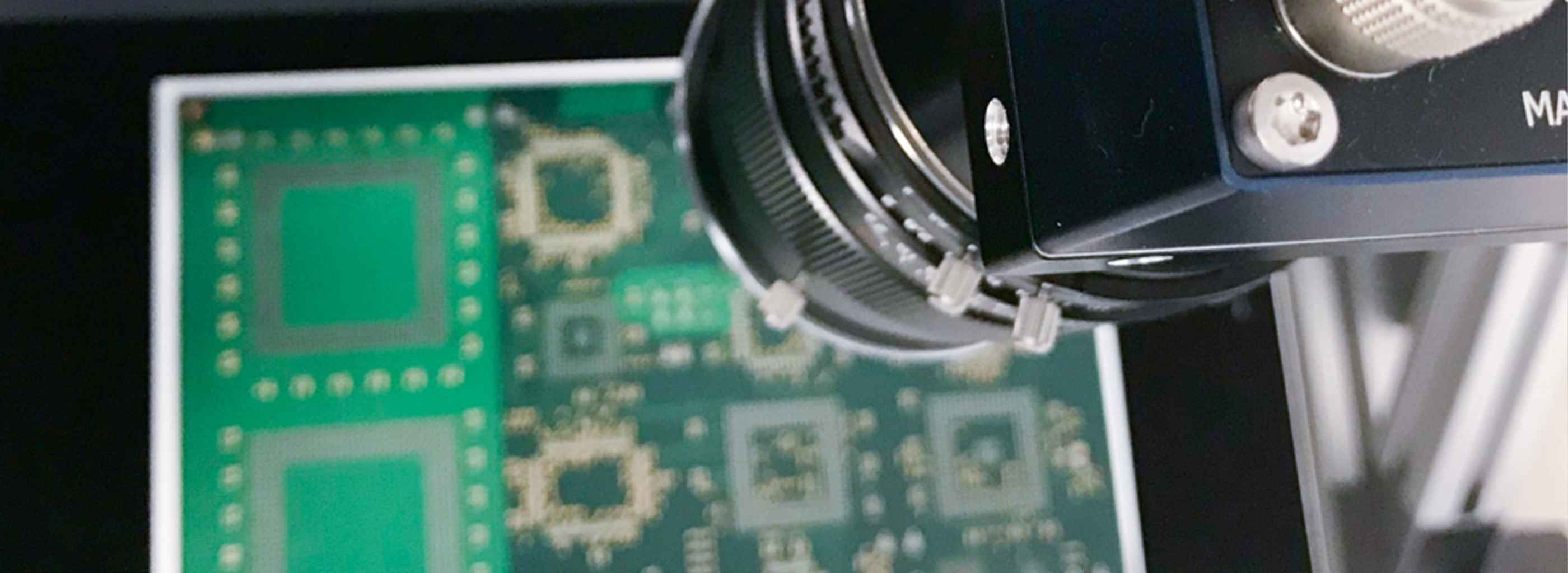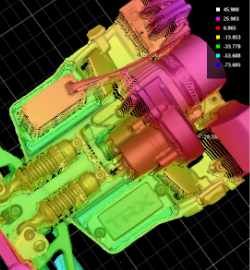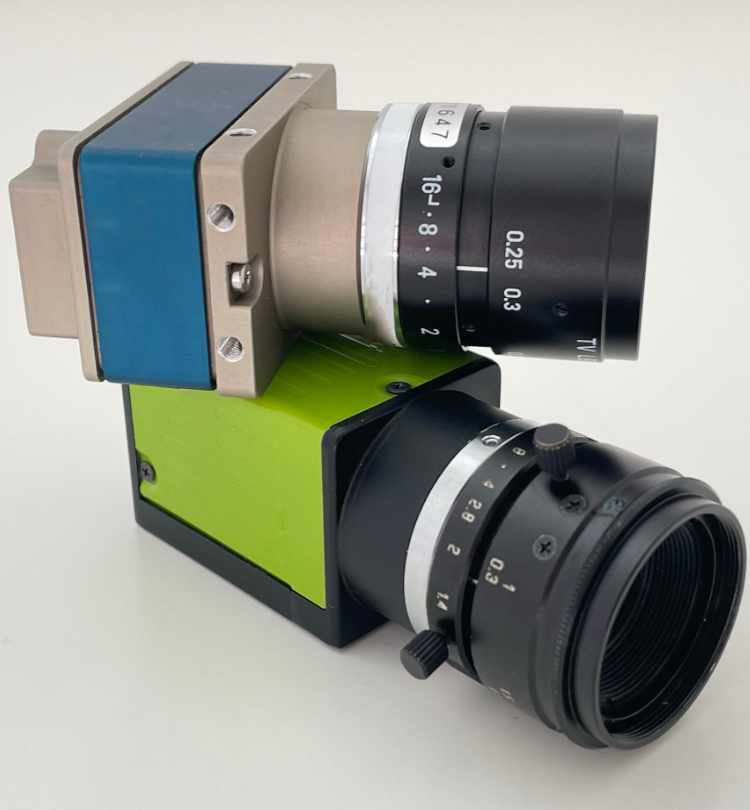
Camera
Choosing the right camera
Image generation is a complex interaction between the material and surface properties of the test object and the lighting used. However, the camera system also plays a central role as the 'detector unit'. In this step, an image is captured on the sensor, processed and digitised
The required accuracy and speed of the inspection, as well as the application requirements for the image sensor, determine the choice of camera technology.
Common industrial camera types

Area scan cameras
Area scan cameras: The matrix sensor simultaneously captures a two-dimensional monochrome or colour image, which is then sent to a PC for software inspection.

Line scan cameras
Line scan cameras: a single linear sensor line captures a large number of individual lines in a very fast sequence. A two-dimensional image is created by the forward speed of the conveyor or camera unit and sent to a PC. This method is ideal for web inspection etc.

3D camera systems
Compared to 2D solutions, they offer a number of advantages. The colour or brightness of the test object plays a subordinate role in the generation of object information. Instead, a 3D point cloud of the object is used for evaluation.

Intelligent cameras
Smart cameras are usually area scan cameras, very rarely line scan or 3D cameras. The image is captured and fully analysed within the camera. The results and measurement data are sent directly to a PLC, robot controller, etc. via various interfaces and protocols. A PC is only required to set up the system.
Selection criteria for cameras (in general)
Area scan camera or line scan camera
Do the parts arrive one at a time or is the material conveyed? In the simplest case, images are captured with an area scan camera that works continuously or is triggered. A line scan camera can be used to seamlessly scan objects as they pass the camera. Long components, endless belts or cylindrical objects that can be rotated are ideal for capturing images with a line scan camera.
2D camera or 3D camera solution
Can all features be reliably inspected with a conventional 2D solution, or do you explicitly need 3D information such as coplanarity, height information and volumes?
Resolution and sensor size
What are the fine features and object structures on the component that need to be captured, and at what level of detail? High camera resolution is particularly important for large components. How large should the sensor be and what optics should be used?
Speed
How many frames per second or lines per second does the camera need to capture? Very fast cameras require fast transfer interfaces. These sensors are often manufactured using CMOS technology, which can read each pixel directly and offer a higher frame rate than (almost obsolete) CCD sensors.
Image quality
How good does the camera image need to be? Higher quality sensors with larger pixels will produce a more uniform image. Also make sure that rolling and global shutter sensors are used correctly. Very good and constant image quality without dark current noise and colour shifts can also be achieved by using thermoelectric cooled industrial cameras.
Monochrome or colour sensor
Can the application be solved with a monochrome or colour camera? Monochrome cameras are much more sensitive to light and the transmitted image data is typically coded with 8 bits. Colour images with 24-bit signal information allow additional image processing to separate different colours with the same brightness (= grey tone), but the data volume is significantly larger. With 1-chip colour cameras, additional detail is lost due to Bayer colour interpolation and measurement accuracy is reduced.
Detection of special spectral ranges
Special camera sensors can be used to detect not only in the visible spectrum, but also X-rays, UV radiation and infrared radiation in the near, medium and far infrared. There are also suitable solutions for this. Further details can be found in the chapter “Detectors and spectral ranges”.
Transmission interface
The required bandwidth per second can be calculated by multiplying bit depth, frame rate and image size. The interface must be able to transfer images quickly and reliably to the evaluation unit (PC). It is also important that the software used supports the transfer interface with the connected camera.
Trigger modes, camera electronics and processing
How should the image be captured, at what bit depth (e.g. 8, 10 or 12 bit monochrome etc.)? Does the image need to be calibrated in the camera? Are burst or sequence triggers etc. required?
Mechanical dimensions and form factor
Will the camera housing fit into the system? Again, there are many different cameras on the market, giving the user a wide choice.
Completeness of the product portfolio
A good supplier should have a complete range of hardware so that you can cover many of your applications with one camera family.
Delivery capability, reliability and support
Find a good, reliable partner. This will help you integrate the camera quickly and not be left out in the cold if a problem arises.
Choosing a 3D camera system
1. Field of view (x, y and z)
The field of view determines how much of an object or scene can be captured. It is important to choose a 3D sensor with a field of view large enough to cover all relevant parts of the object. The x, y and z dimensions indicate the maximum size of the detection volume.
2. Motion
Another criterion is the ability for motion. A decision must be made as to whether the sensor should remain static or move to capture different perspectives. A static system is easier to implement, while a moving system can be more flexible to fully capture complex objects.
3. Needed resolution (x, y and z)
The resolution of the 3D sensor affects the accuracy and detail of the captured data. High resolution is particularly important for applications that require fine detail. Resolution is often specified in x, y and z and should meet the requirements of the specific application.
4. Free working distance
Free working distance refers to the area between the sensor and the object to be detected. An appropriate working distance ensures that the system can operate efficiently without the need to adjust the sensor or the object. It is important that the working distance is large enough to detect the entire object, but small enough to ensure high resolution and detail.
5. Dimensions, IP class, weight
The physical dimensions, IP rating and weight of the 3D vision system are also important selection criteria. These factors influence the integration of the system into the existing environment and its handling.
Especially in industrial robotics, a heavy sensor could cause problems with small robots. However, size and weight are also a serious problem in transport and drone applications.
6. Cycle time image acquisition & processing time
The cycle time for image acquisition and the time for data processing are critical factors in the overall performance of the 3D vision system. A short cycle time enables faster image acquisition, which is particularly important for industrial applications. Image processing time affects how quickly the captured data can be analysed and used. It is important to choose a system that provides both fast image acquisition and efficient data processing.
7. Type of material of the component
The material type of the object to be scanned plays an important role in the choice of 3D vision system. Materials can be cooperative (matte and opaque), glossy or transparent. Each material places different demands on the sensor and image processing algorithms.
8. Special features
Some 3D imaging systems offer special features such as texture image, multi-slope and HDR (high dynamic range). These features can improve the acquisition and inspection of 3D data and should be considered depending on the application requirements. Special trigger modes may also be features that are only available on specialised systems.
9. User skills
The choice of system also depends on the skills of the user. Smart cameras are often easier to use and are suitable for users with less technical knowledge. PC-based systems offer more flexibility and power, but also require advanced knowledge. What do you need?
10. Budget
Sometimes the potential investment costs are a clear priority. What is the best solution for a given budget? Again, there are often trade-offs to be made.
Need to buy the right camera?
Vision-Doctor.com is a private, independent, non-commercial homepage project and not a technology provider or system integrator. Suitable technologies and further professional support can be obtained from the companies & partners listed below.
If necessary, I will be happy to provide a quick recommendation, contacts and brief information.















